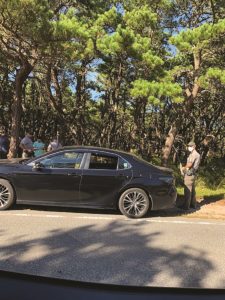As U.S. police forces face a reckoning, issues of transparency and racial equity are on the table at the State House in Boston. A conference committee works on a bill that aims to “reform police standards and shift resources to build a more equitable, fair and just commonwealth that values Black lives and communities of color.” But as Massachusetts joins a nationwide conversation, one Outer Cape police force finds itself outside it: law enforcement rangers in the Cape Cod National Seashore.
The Seashore covers 43,607 acres from Chatham to Provincetown. Three very different types of federal agents — all rangers — oversee the parkland.

Research rangers concern themselves with natural resources and history; interpretive rangers staff visitor centers, offer cultural information, and guide tours. The Seashore also has a permanent staff of 11 law enforcement rangers. They are supplemented by eight seasonal rangers from April through September.
Law enforcement rangers wield the same authority as U.S. marshals and F.B.I. officers. Each carries a sidearm and a long gun. They have primary jurisdiction over 27,000 acres of the Seashore, and are responsible (“in close collaboration with town police departments,” said Supt. Brian Carlstrom) for enforcing federal law there.
“The work of a law enforcement ranger has three prongs,” said Leslie Reynolds, the Seashore’s deputy supt. and former chief ranger. “We protect the people from the people: domestic violence, driving under the influence of alcohol or drugs, theft. We protect people from the park: If you get lost, we’ll try to find you. If you get separated from your group, we’ll try to reunite you. If you’re injured, we’ll treat you. And last, we protect the park from the people: we make sure people don’t pick flowers or collect minerals they’re not supposed to, or vandalize, dump in the park, or poach.”
Reynolds stressed that law enforcement rangers deal most often with just two types of issues: park versus people, and people versus park.
In 2019, permit issues made up 6 percent of the violations and accounted for 14 percent of rangers’ warnings; 16 percent of violations were for drug and alcohol use; 13 percent were for pets. Out-of-bounds camping was to blame for 2 percent of warnings. Nudity at Provincetown beaches accounted, Reynolds said, for “quite a lot” of work.
But the vast majority of the rangers’ contacts with the public — 56 percent of warnings and 48 percent of violation notices — fell into one category: traffic stops.
Analyzing data from traffic stops is widely accepted as the best way to gauge racial bias in policing. Disproportion between the size of a town’s community of color and the percentage of drivers of color pulled over by law enforcement can indicate bias. So do differences between the number of nonwhite drivers stopped during daylight versus at night; a Stanford-led study published in May analyzed 95 million records and found that, after sunset, when “a veil of darkness” masks race, police officers were much less likely to pull over black drivers.
Police departments in Orleans, Eastham, Wellfleet, and Provincetown already collect racial data for every traffic stop, even those that don’t result in a citation or arrest. And section 63(d)5 of the proposed Reform, Shift, and Build Act would make mandatory an annual review by every Massachusetts police department of its stop and search data, an analysis of racial or other disparities, and the publication of a report detailing said analysis.
That legislation, though, would evidently not apply to the Seashore police. They are subject to federal reporting guidelines.
When a law enforcement ranger makes a contact, a Boston-based dispatcher inputs the information into a computer-aided dispatch, or CAD, system, which feeds into an information management system (IMARS) shared by park rangers and park police across the entire National Park Service.
Once the dispatcher has done that, it’s up to the ranger to input additional information. That includes, said Reynolds, whether the subject of the incident was adult or juvenile, male or female. It includes hair color, eye color, height, and weight — but, per these federal guidelines, not race.
“The only time the rangers would identify the race of a person,” said Reynolds, “would be a search and rescue, if we needed the public’s help finding someone.”
This means that statistics on race are nearly entirely absent from the National Park Service’s law enforcement records, which are accessible only by filing a Freedom of Information Act request.
Deputy Supt. Reynolds maintained that Seashore police could not record data on the race of the people they stop because “there’s not a box” for it on the form.
“Because it’s not there, we simply can’t look at our violation notices and pull the data about race,” she said. “I think, certainly, data is very important when you analyze it for any sort of issue. How many women do we stop compared to men? How many people do we stop that have blue eyes compared to brown eyes?”
The Independent this week requested information about an incident in the Seashore in which a resident photographed a group of rangers stopping, interrogating, and searching four visitors of color. (See photo above.) Neither Reynolds nor Acting Chief Ranger Ryan Wright responded to the request.
The bottom line is this: it’s impossible to gauge whether racial bias is a problem in policing in the national park because those data simply do not exist.
